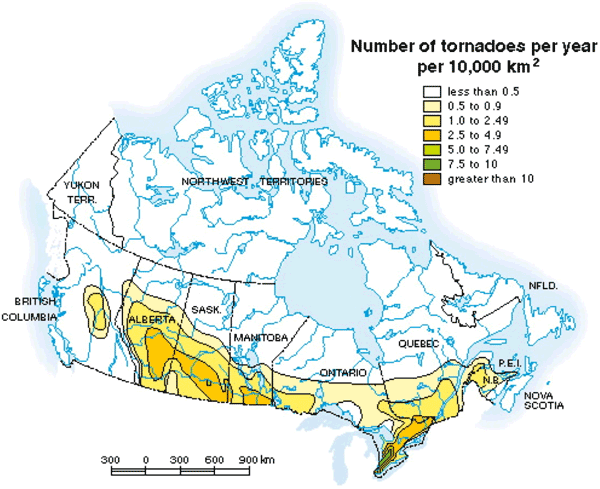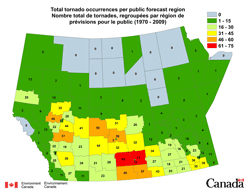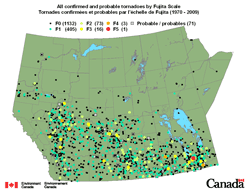Tornado
Tornadoes are intense storms which can arise suddenly and are highly destructive. Tornadoes are expected to increase in frequency and intensity. Efforts to mitigate against tornadoes include reducing the risk to life and property through education, emergency preparedness and insurance.
Tornadoes are a strong vortex extending down from a cloud resulting from the mixing of warm, humid air with cool northern air masses. Records indicate that Canada experiences around 80 tornadoes a year and that Saskatchewan is one of the areas of high occurrence (Figure 1 and 2). The majority of tornadoes are weak (i.e. low on the Fujita Scale (Figure 3).
Canada’s deadliest tornado occurred in Regina on June 30, 1912 when 28 people died. Other notable tornadoes were experienced in 1920 - SE Saskatchewan, 1950 - Regina, 1989 - Montmartre and 2010 - Kwacatoose First Nation near Raymore.
Adaptation Actions
Actions that can be taken to minimize the risk and mitigate the effects of tornadoes include:
- Construct buildings to code
- Learn to recognize weather patterns and cloud formations that may develop into a tornado. Tornadoes generally track southwest to northeast.
- Become familiar with forecasting information available via the media and on the internet such as weather radar.
- Improve predictions and warning capability.
- Prepare for power outages.
- Insure against the risk of tornadoes where warranted and cost effective.
- Continue with emergency management and disaster assistance program.
Sources:
- Atlas of Canada (2007): Map of Annual Number of Tornadoes in Canada, Natural Resources Canada http://atlas.nrcan.gc.ca/site/english/maps/environment/naturalhazards/naturalhazards1999/majortornadoes/number_tornadoes_per_year.gif/image_view [accessed February 6, 2011]
- Environment Canada (n.d.): Tornadoes - Atmospheric Hazards – Prairie and Northern Region http://pnr.hazards.ca/tornado.html [accessed February 6, 2011]
- Environment Canada (n.d.): Hazardous Weather http://www.ec.gc.ca/meteo-weather/default.asp?lang=En&n=15E59C08-1 [accessed December 4, 2010]
- Environment Canada (n.d.): Atmospheric Hazards Northern and Prairie Region http://pnr.hazards.ca/welcome_english.html [accessed December 4, 2010]
- Environment Canada (2010): Saskatchewan’s Summer of Storms. Canada’s Top Ten Weather Stories for 2010 http://www.ec.gc.ca/meteo-weather/default.asp?lang=En&n=9CA5E424-1 [accessed Februayr 15, 2011]
- Government of Canada (n.d.): Is Your Family Prepared? Severe Storms in Canada http://www.getprepared.gc.ca/knw/ris/str-eng.aspx#b1 [accessed February 4, 2011]
- Public Safety Canada (2010): Canadian Disaster Database http://www.publicsafety.gc.ca/prg/em/cdd/srch-eng.aspx [accessed Februaray 8, 2011]
- The Weather Doctor (2008): Tornadoes in Canada Weather Almanac for June 2008 http://www.islandnet.com/~see/weather/almanac/arc2008/alm08jun.htm
- Wikipedia, (n.d.): List of Canadian tornadoes and tornado outbreaks. https://secure.wikimedia.org/wikipedia/en/wiki/List_of_Canadian_tornadoes_and_tornado_outbreaks



